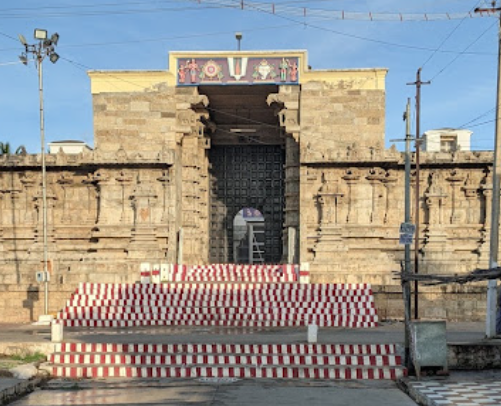According to legend, Lord Vishnu, in His Varaha Avatara, rescued the Earth from the demon Hiranyaksha, who had tried to seize it. Seeking Lord Varaha's guidance, Mother Earth was instructed that He could be reached through music.
On the sacred Kaisika Ekadasi day, a man from a backward community encountered a ghost. As the ghost threatened to devour him, the man promised to return after singing Lord Vishnu's praises. He fulfilled this promise by singing hymns in devotion to the Lord. Through this act of devotion, the man attained salvation, and the ghost, having heard the praises of the Lord, also achieved liberation.
Sthala Puranam:
Thirukkurungudi is renowned as "Vaamana Kshetram," dedicated to the Vamana Avatar of Sriman Narayanan. Lord Vamana was born in the Puratasi month on Shukla Paksha Sravana Dwadasi, to Kaasyabha Maharishi and Athithi. This day is known as Vijaya Dwadasi.
Lord Vamana was instructed in the Savithri Mantram by Suryan, and Vyazha Guru Bragaspathi taught him the Brahma Soothiram. Born to Maharishi Kaashyapa, Vamana's attire and activities mirrored those of a sage. He received various divine gifts:
- Dharbai (sacred grass) from his father Kashyapa Maharshi.
- Krishna Aasanam (seat) from Bhoomi (Earth).
- Thandi (support for the hand) from Chandran.
- Kaupeenam (clothes) from Athithi.
- Kamandalam (water vessel) from Brahma.
- Various vessels from Guberan.
- Vedic teachings from Bharadwaja Maharshi.
- Food from Parasakthi, offered with her hand when he begged for alms.
Despite performing his divine duties as Vamana, He manifests in this sthalam in a short muni form, which is why it is called "Kurungudi."
When Lord Shiva incurred Brahmagathi Dosham by plucking Brahma's head, he visited this sthalam. Following Nindra Nambi's guidance, Lord Shiva sought food from Kurungudi Valli Thayar to alleviate his dosham. After receiving the food and learning Sudarshana Japa from Vamana, he was liberated from his dosham.
Lord Nindra Nambi's grace led to the birth of Nammalvar to his mother, Udaya Nangai. Thirumangai Alwar attained Mukti (liberation) at this sthalam, and a small temple named "Thirumangai Alwar Thiruvarasu" was constructed on the riverbank to commemorate this.
The name "Nambu" means belief, and "Nambi" signifies one who is believed by all. Lord Nindra Nambi, revered for his forms (Nindra, Kidantha, and Irundha Thirukkolam), is deeply worshipped by devotees. Similarly, Lord Shiva, who came to seek darshan and received liberation from his dosham, is worshipped in the form of Magendranadhar in a separate sannadhi situated between the Kidantha Nambi and Irundha Nambi sannadhi’s.
Near Kurungudi, there lived a musician named Baanan who wished to worship Kurungudi Nambi on Sukla Paksha Ekadashi. On his way, a Brahma Rakshasa (a wild demon) threatened to devour him due to hunger. Baanan requested to be spared until he could have darshan of Kurungudi Nambi and sing his praises. The demon agreed and waited.
Upon reaching Kurungudi, Baanan sang devotional hymns in front of the temple entrance. Although the Kodimaram (flag post) initially blocked his view, it moved aside, allowing him to see the deity. His devotion and musical praise satisfied Kurungudi Nambi, who honoured him with the title "Nampaaduvaan," meaning "one who sings for the Lord."
After receiving the title and darshan, Baanan returned to the demon. When the demon inquired about his song, Baanan recounted it, and the demon's hunger was replaced with spiritual satisfaction. The demon was so moved that he released Baanan. This story is recounted in the Varaha Puranam and is performed as a drama during Kausika Ekadesi.
The temple's prasadam (food offerings) are also offered to Lord Shiva. Inside the temple, there is a Mattaiyadi Mandapam and a Nadhi Mandapam, with the Kodimaram featuring rare sculptures. The Kulasekara Mandapam houses an ancient bell donated by a king from Thiruvidhangodu.
Moolavar Nindra Nambi, also known as "Pari Pooranan," is enshrined with two Pirattis. Nearby, the utsavar (processional deity) is Vainava Nambi, accompanied by Neela Devi and Kurungudi Valli Thayar.
In the south prakaram, there is a separate sannadhi for Lakshmi Narasimhar and Lakshmi Sametha Varaha Moorthy, while the west prakaram features the Dasavatharam (ten avatars of Vishnu), Srinivasa Perumal, Andal, and Kurungudi Valli Thaayar sannadhi.
The temple also houses sannadhis for Nindra Nambi, Veetrirundha Nambi, and Kidantha Nambi. Close to Nambi's feet, the head of Mahabali is enshrined. Irundha Nambi is also known as "Vaikundhanadhan." Malaimel Nambi is located 5 km from this sthalam on a hilltop. Kurungudiyavan Kudi is another name for Vamana and is situated ½ mile south. The river "Thiruppaarkadal," ½ mile away, has the Thiruparkadal Nambi sannadhi.
